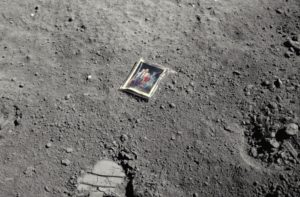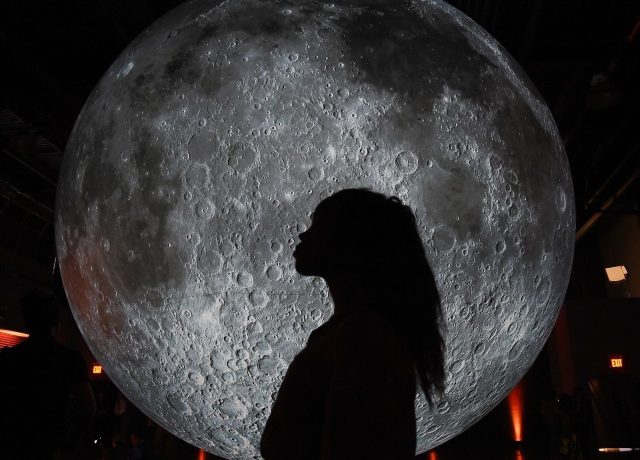The dozen Moonwalkers to date have all been men. Credit: Ilya S. Savenok/Getty Images

The Moon is feminine in French – in all the Romance languages, in fact. Even in English, which does not assign genders to inanimate objects, the Moon is presumed female. Her sex was likely decided ages ago by association with the chaste huntresses of ancient myth, Artemis and Diana, not to mention the match of the Moon’s monthly phases with the pace of the human menstrual cycle.
But despite its womanly aspects, the Moon today is a decidedly masculine domain: The markings on its surface add up to a “man in the Moon” for most casual observers, and the dozen Moonwalkers to date have all been men. What’s more, four hundred years of mapping and naming the Moon’s craters, rilles and basins have yielded only 28 lunar features named in honour of women. The few individuals commemorated in this fashion are as revered as Madame Marie Curie, as venerated as Saint Catherine of Alexandria. Among them stands Mount Marilyn, discovered during the flight of Apollo 8 by astronaut Jim Lovell, who called the landmark by his wife’s name so he’d be sure to remember it.
Lovell flew to the Moon twice without landing there – a missed opportunity he lamented in the title of his book, Lost Moon. Still he came closer than any of his female contemporaries who also aspired to spaceflight, and for whom the Moon proved an altogether lost cause. The death this past spring of aviator Geraldyn “Jerrie” Cobb at age 88 brought the memory of the original “Mercury 13” women wannabe astronauts briefly back into the news.
In 1960 Jerrie Cobb, a pilot since her teens (and also a semi-pro softball player for the Oklahoma City Queens), became the first woman to undergo the same gruelling physical and psychological tests required of the men known as the Mercury 7 – the exclusive fraternity of first astronauts. Cobb passed the tests, demonstrating high ability. She thought she stood on the threshold of liftoff, especially since NASA’s rival space agency in the Soviet Union had hinted its readiness to launch a female cosmonaut. In a television interview, Cobb spoke openly of the disappointment she felt in June 1963, when Valentina Tereshkova pre-empted her as the first woman to rocket into space.
Cobb could not vie even for second-place in the first-woman-in-space race. She and her twelve fellow members of the Mercury 13 stayed Earthbound, trapped in the gender stereotypes of the time. They all lacked what NASA then deemed a crucial qualification, namely experience as a military jet test pilot. Fifteen years would pass before any woman could legitimately apply to train as a bona fide astronaut candidate, beginning in 1978. Five years after that, Sally Ride became a household name during her historic 1983 flight as the first American woman in space.
Thanks to the more enlightened attitude that prevailed during the Space Shuttle program, many female mission specialists got to score new firsts – the first mother in space, the first British woman in space (even before the first British man), first Canadian woman in space, first wife to fly a space mission with her husband, first black woman in space, first Hispanic woman in space, first Japanese woman in space, and, most notably, first woman to pilot and command a Shuttle mission. It still chills me to remember that the first teacher in space would also have been a woman, had her vehicle, the Space Shuttle called Challenger, not disintegrated in a horrific explosion only moments after leaving the launch pad at Cape Canaveral.
In general, each of the female space firsts remained the only such individual in her category of distinction, and yet there were enough female forms on Shuttle flights for NASA seamstresses to sew spacesuits in a wide range of sizes through the 1990s.
No such wardrobe surplus survives today aboard the International Space Station. This situation dashed hopes a few months ago, when plans for the first all-female spacewalk fell apart because there was only one extravehicular mobility unit on hand in a size small enough for either of the two women on the resident crew.
The Space Station flies in “low-Earth orbit.” At an altitude of about 250 miles (400 kilometres), the Station is so close by that a new crew member travelling there via Russian spaceship can arrive in just six hours. The far more distant Moon lies some quarter-million miles farther away. The woman who can boast the closest contact with the Moon may well be my friend Carolyn, who was gifted a sprinkle of real Moon dust by a science-minded admirer during the heady days of the Apollo project. Without hesitation, she swallowed it.
The numerous global celebrations this week marking the fiftieth anniversary of the first lunar landing commemorate each stage of the ambitious Apollo 11 itinerary. It took the astronauts three days to fly to the Moon by the fastest available means. They spent a scant few hours exploring the surface before regrouping and heading homeward to splash down in the Pacific Ocean.
In the current hoopla over those first footsteps on another world, it is sobering to recall how quickly the public tired of watching Apollo astronauts hop about the barren but beautiful lunar landscape. When heartbeats subsided after the “problem” that threatened the lives of the Apollo 13 crew, the Moon ceased to be prime viewing. NASA discovered that lunar exploration could be achieved faster, better and cheaper by robots. The portion of the population favouring conspiracy theories became convinced that the Moon landings had been faked. And that population percentage, believe it or not, grows larger every year.
Apparently it will take a woman to reverse the dispiriting trend. In recent announcements of its new lunar initiatives, NASA projects that a female astronaut will disembark at the Moon’s south pole sometime in 2024. This dream is no continuation of the old Apollo program, but a novel effort named for Artemis, Apollo’s twin sister, the virgin Moon goddess of the hunt, also of wilderness, wild animals, and young children.
Preliminary studies under the Artemis aegis have already been selected for funding. The twelve chosen science questions relate to various aspects of astronaut health, such as the physical stress of spaceflight (bone loss, sleep disturbances, and the like) as well as the potential of space radiation to cause breast and ovarian cancer.
Implementation of Artemis will unite NASA with numerous commercial enterprises, and also strengthen its ties to ESA, the European Space Agency.
In place of the series of sorties that characterised the Apollo program, Artemis aims to establish a sustained human presence on the Moon by 2028.
I can hardly wait to see who she will be.










Join the discussion
Join like minded readers that support our journalism by becoming a paid subscriber
To join the discussion in the comments, become a paid subscriber.
Join like minded readers that support our journalism, read unlimited articles and enjoy other subscriber-only benefits.
Subscribe